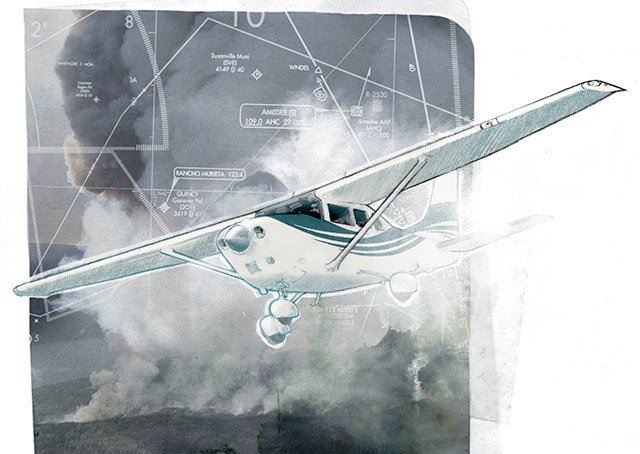
Changing conditions catch recon pilot off guard
July and August 1999 were typically hot, dry, and windy in the Sierra Nevada—especially so in the Plumas National Forest. As humidity readings steadily dropped, Forest Service personnel geared up for what surely was going to be a long and busy fire season. All that was needed was a source of ignition, and Mother Nature was about to oblige.
In the third week of August, a series of dry lightning storms struck the Plumas, sparking dozens of wildland fires in the tinder-dry vegetation.
Almost immediately the phone rang at our FBO, Sugarpine Aviators. It was Plumas Dispatch with an order to launch Recon 40 to locate and report smokes on the forest.
For the past 18 years, I had been authorized by the U.S. Forest Service to fly reconnaissance and supplemental air attack in our 1965 Cessna 206. The familiar drill was to top off the aircraft, fill out the paperwork, install the Forest Service radio pack, and launch with a Forest Service aerial observer on board.
By the end of August two large fires in the North Fork of the Feather River drainage had gotten out of control as fire crews were overwhelmed by the number of starts and limited resources. This is rugged, heavily timbered, unforgiving country. The fires would eventually grow to more than 34,000 acres and became known as the Big and Bucks fires. And yes, they ended up costing big bucks to put out.
When a fire exceeds the size and ability of local Forest Service resources to contain, a special unit called a Type 1 Team is called in. The highly experienced team, led by an incident commander, coordinates all aspects of fire suppression, including aerial resources. My job now switched from Recon 40 to Air Attack 11, flying with the Type 1 Team air attack supervisor.
Only a handful of personnel in each Forest Service region are qualified as air attack supervisors. Years of fire behavior experience on the ground are required, as well as intimate knowledge of the speed and load-carrying capacity of each lead airplane, air tanker, and helicopter assigned to the incident. Their responsibility is to direct fixed-wing retardant drops, rotary-wing water drops, and supply missions—and to look out for the welfare of firefighters on the ground. To accomplish this, four or more frequencies must be monitored at once, including forest net for flight following; fire net for ground communication; two tactical frequencies, for air tanker and helicopter operations; and local unicom if near an airport. In the chaos of initial attack, this can be overwhelming for the air attack supervisor, so the pilot often handles two frequencies for him.
The air attack supervisor and I had circled these fires dozens of times and watched as the two fires slowly started to merge into one large conflagration. Other than coordinating the occasional retardant drop and scanning the surrounding airspace for incursions into the temporary flight restriction, the routine changed little. Occasionally, my mind wandered in the afternoon heat. To pass the time, I focused more on locating a fishing lake or deer-hunting area, instead of noticing the changing conditions of the smoke column.
Suddenly, I heard a request from a Hot Shot crew member on the Bucks fire. Hot Shot crews are elite wildland firefighters, sent into the most dangerous terrain to construct control lines in advance of the flames. This was no exception, as the person requesting assistance was on a steep, brushy, rattlesnake-infested slope at the head of the fire. The crew member said, “Sling me in another chain saw. This one just burnt up.”
Wanting to get a better fix on her location, I increased the bank angle and looked down through the haze longer than I should have. As I looked up, with no time to react, we flew directly into the smoke column of these two huge fires that had suddenly merged. The column of an out-of-control, large forest fire looks like an atom bomb went off. These monsters form what is called a plume-dominated fire, creating their own weather—including lightning and tornado-like wind vortices.
The initial jolt of turbulence was significant, but what worried me most was knowing that severe updrafts were rapidly hurling chunks of burning limbs and debris skyward. In this situation, had we struck an object, our chances of a safe outcome would be severely limited. A forced landing in the dense smoke was at best problematic.
I immediately went on the gauges and tried not to think about what was sailing past us in the zero visibility. Seat belts strained as we transitioned from eerily calm air to severe turbulence in a matter of seconds. My eyes were glued mainly to the directional gyro and the attitude indicator as I fought to maintain heading and control of the aircraft. I could only imagine what the air attack supervisor was thinking.
After what seemed like forever, we suddenly emerged into clear blue sky on the opposite side of the column. Luckily, we never hit anything while gaining 2,000 feet of altitude in the updrafts.
I apologized to my passenger and suggested we return to base for fuel. He never said a word about the incident to me, but I overheard him remark to a colleague that he should put in for hazard pay. The lesson I learned that day was no matter how much experience you have, lack of situational awareness—coupled with complacency—is a dangerous combination.AOPA
Tom Rahn, of Greenville, California, is a CFII with multiengine rating. Retired from a 30-year career as chief pilot for a fixed-base operator in Quincy, California, he has logged more than 15,300 hours, of which 4,300 were mountain flying instruction.
Digital Extra Hear this and other original “Never Again” stories as podcasts every month on iTunes and download audio files free.


